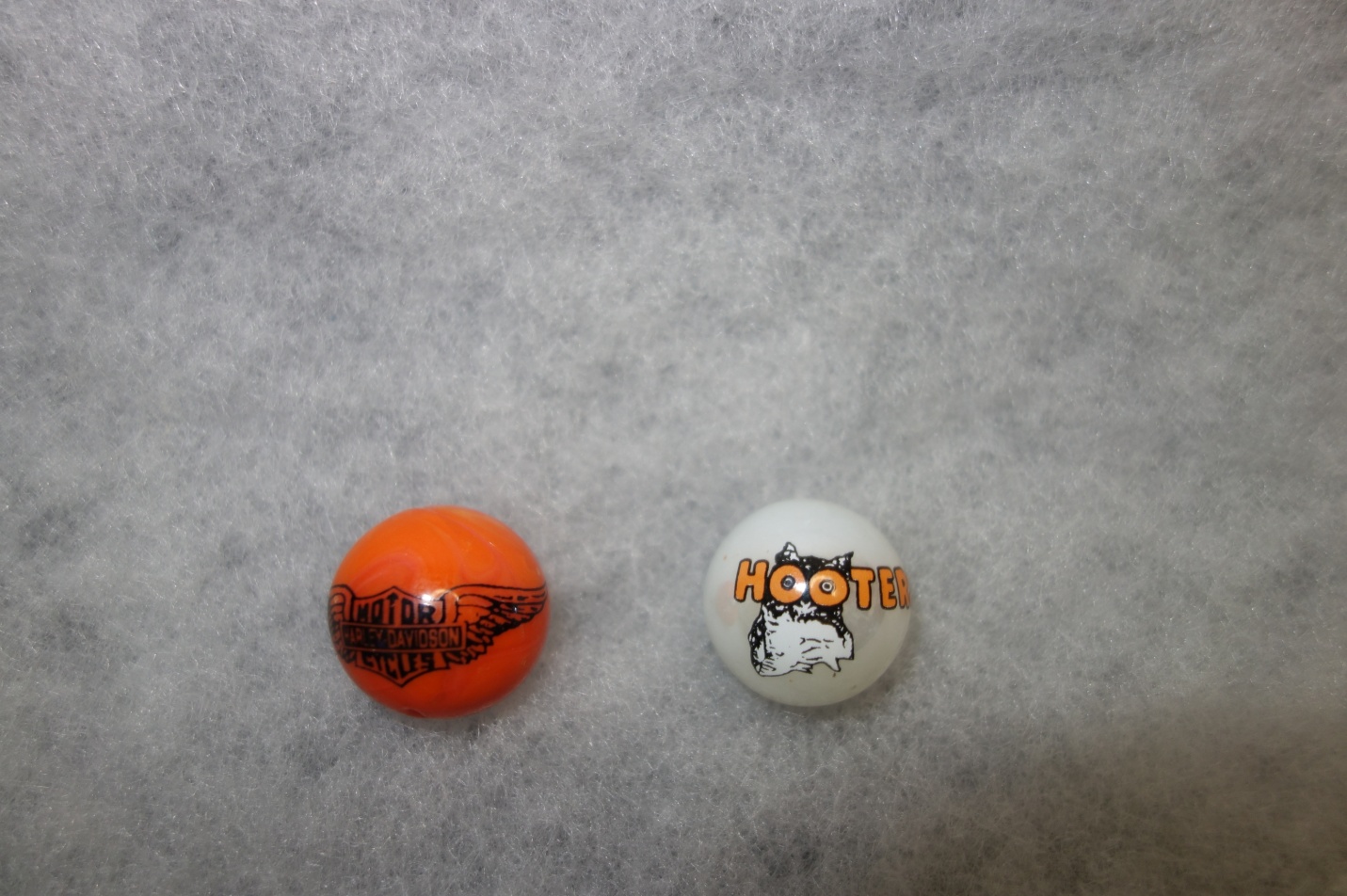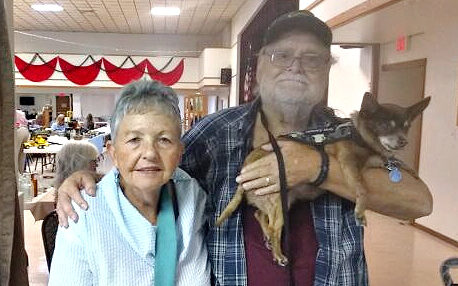
Character, comic, and advertising marbles are hotly debated in the collecting world. There is often a search for relevance: Is the marble real or is it a fake? While the answer to this question determines the monetary value for any of these marbles, it is less important in determining its relevance.
Oh, No! It’s A Fake!
So what if it is a fake. These imprinted marbles still have a story to tell. Sometimes their back story is better than their monetary value, and almost always they can tell us something about American history.
Aren’t Comic Marbles Real?
Marbles featuring images of comic characters were made about 1932-1938 by the Peltier Glass Company, which perfected the method for firing them. These were taken right from newspapers and comic book strips and reflected American humor of the time. A series of 12 “picture” marbles were made. Who didn’t chuckle at the adventures Emma or Skeezik? Let’s buy marbles for our favorite comic characters!
Which Ones Were Real?
Those comic marbles created by the Peltier Glass company 1932-1938 are genuine, and there are twelve that are accepted as real.
There are five more “specialty” marbles from that time which promote movie characters and VIPs: Tom Mix, Cotes Master Loaf, Herbert Hoover, Franklin Roosevelt, and Babe Ruth.
What About All the Others?
The production of comic and picture marbles did not stop when their licensing ended at Peltier Glass Co. in 1938. These original marbles had proven very popular and lucrative. Even today, they might sell for hundreds of dollars.
The Updated Versions
Although there are still some unauthorized duplicates made, new American faces, images, and slogans appear on modern versions. These may celebrate contemporary characters (such as Biden and Trump) or promote businesses…all of them considered “advertising”.
Because these are not listed among the original Peltier character or specialty marbles from the 1930s, they are not highly collectible or valuable. But why not collect these? Read more about fakes and fantasies on the previous post As Real As A $3 bill.
We have one contemporary character marble for sale in our magazine shop at https://thesecretlifeofmarbles.com/product/moon-mullins-character-marble/
What They Tell Us
If you have one of these advertising or promotional marbles, research what it can tell you. There is almost always information online. Some “fake” marbles’ stories are really fascinating and a few of them, while unbelievable, are actually true[1].
So, just for the moment, let’s put all that we know about fakes, fantasies, and frauds aside and just think about the fun of collecting advertising marbles!
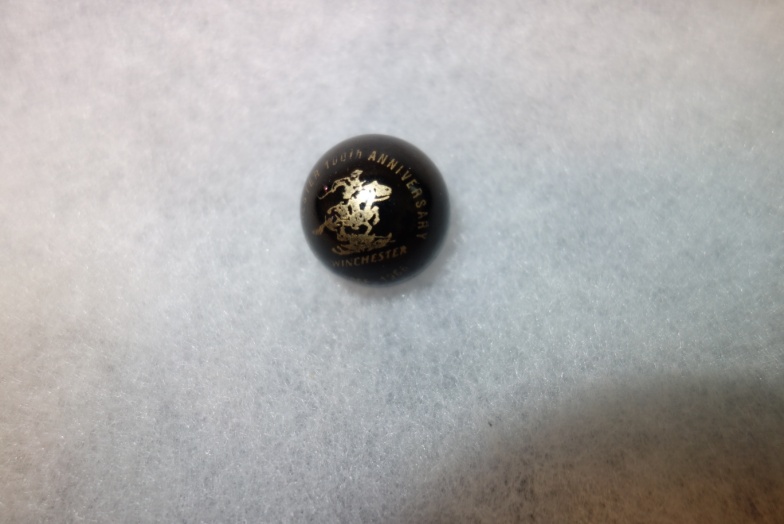
Winchester Marble
Our featured photograph shows this one inch black glass marble with golden screen print. We bought it in February 2013 at the Sunshine Flea Market in Lake Wales, Florida.
This marble is the hardest thing we have ever tried to photograph! We used every trick we know and we are still not happy with the results.
As noted the marble is a 1” black glass marble with gold screen print apparently issued to commemorate the 100th anniversary of Winchester [Repeating Arms, Morgan Utah; 1866 – 1966]. Only the name Winchester is printed on the marble.
The logo is extremely detailed and very difficult to read on a round shiny marble. We use a 10-power loop to study it, and the gold looks remarkable under this magnification. We are amazed at the gold refraction! We can only imagine that the decal is screen printed.
This is not a rare marble. Marbles like it can be found for sale online. On the other hand, when we started researching the marble in 2013 and again more recently, we could find no hard and fast evidence about it.
We have read online that it was not distributed in 1966, but we have no solid proof one way or another as to which company made the marble, who screen printed it, and who distributed it and when. It has also been suggested that, based on the actual design with the horse and rider and the Winchester name below, it looks like it might be from the mid-1990s.[2]
Winchester Show & Tell
We went online with the “Show and Tell” feature of Collectors Weekly . This site allows users to post artifacts which they are curious about, they want to know more about, or they simply want to share with other users. We did gather a number of well-researched responses there regarding this Winchester marble.
Library of Congress
To say the least, Winchester company history is both long and complicated. We studied the various references which the Collectors Weekly subscribers suggested. We also referred to the Library of Congress (LOC).[3]
From the LOC: “Oliver Winchester and John M. Davies purchased the bankrupt original company of Horace Smith and Daniel B. Wesson in 1856, and reorganized it as the New Haven Arms Company in April 1857. …In 1866 Oliver Winchester reorganized the company as the Winchester Repeating Arms Company….”
Olin Corporation acquired Winchester Repeating arms in 1931.[4] In December 1980, Olin Corporation retained Winchester’s ammunition business, but sold the New Haven plant to its employees who then incorporated it as the U.S. Repeating Arms Company with a license to make Winchester Arms.”
After its 1989 bankruptcy, the company was acquired by the Belgian arms maker, FN Herstal, …. The privately owned company continues to manufacture under the Winchester Repeating Arms brand.” (LOC)
Trust us, it is a very tangled web. Not only that, but trademarks are, if possible, even more complicated. So, we will just list a very few “snippets” from the readers of Collectors Weekly. You can check their web site if you want to follow-up on their recommended sources.
Winchester Snippets related to this Advertising Marble
- 1919 Phillip R. Goodwin creates the horse and the rider cradling a Winchester rifle. Goodwin was a master of “predicament” art.
- 1931 Even before the Olin Corporation took over in 1931, Winchester was making a lot of products that weren’t related to firearms.
- 1965. While the “Horse & Rider” have been part of Winchester’s brand since 1919 when it was used by the Winchester Repeating Arms Company, it’s not until now that the “Horse & Rider” trademark is officially registered.
- 1966 Winchester did produce 100th Anniversary wine glasses, and a clock.
- There are a lot of trademarks that the Olin Corporation registered for use of the Winchester horse and rider image, including firearms, ammunition, chocolate, coffee, and jerky.
Waterloo Boy Green?
We were gifted with this 1” iridescent (opalescent) marble in November 2019. It was purchased at an antique store in Woodbury, Tennessee.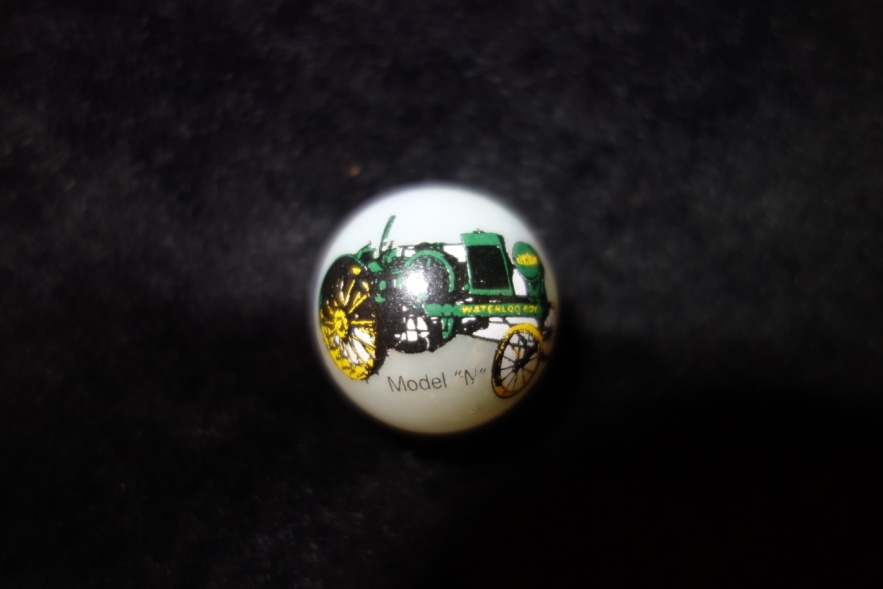
The detail on this one, and the writing, are about as small as the decal on the Winchester marble and, again, we needed the 10X loop. This one has a green, yellow, and black screen transfer of a tractor. It is very nicely done, but you can feel the transfer under your thumb. No, we have not attempted to scrape it off!
When we first got this modern marble, we thought we were looking at a toy advertised by Waterloo. We thought it says “Waterloo Toy” rather than “Waterloo Boy.” You may be more up on this than we are, but we had never heard of the town Waterloo in Iowa nor had we heard about their tractor works[5].
Waterloo Kerosene Gasoline Tractors?
When we researched the marble we learned that Waterloo tractors were made between 1916 – 1924. “The Waterloo Gasoline Engine Company was the first company to manufacture and sell gasoline powered farm tractors. Based in Waterloo, Iowa, the company was created by John Froelich and a group of Iowa businessmen in 1893, and was originally named the Waterloo Gasoline Traction Engine Company.
In 1892, Froelich had invented the first practical gasoline-powered tractor, and the new company was given the opportunity to manufacture and sell the tractor Froelich designed. The tractor was not successful commercially.
In 1895, the company was sold to John W. Miller and renamed the Waterloo Gasoline Engine Company. Miller decided to stop producing tractors and instead focus on building plain gasoline engines.[6]
Cut to the Chase or Oh Deere!
Waterloo made tractors again in 1913 and in 1914 they produced the Model “R”. The model “N” on the marble was made in 1916, and, oddly enough considering the name of the company, both models burned kerosene. Thousands were made and sold.
Nothing Runs like a Waterloo Boy!
Just doesn’t have the same ring, does it? Well, in 1918 Deere & Company, which dates to 1836 and which had been doing business as Deere & Company since 1868, bought Waterloo Gasoline Engine Company for $2,100,000.[7]
When we learned how much Deere paid Waterloo, we just kept looking at the amount! Two million dollars! Waterloo and Waterloo Boy cost Deere almost $35,000,000 in today’s money! That just astounds us but we have cross-checked the numbers. It’s correct.
Although Deere became the John Deere Tractor Company when they bought Waterloo, they continued to make and sale Waterloo tractors until 1923.
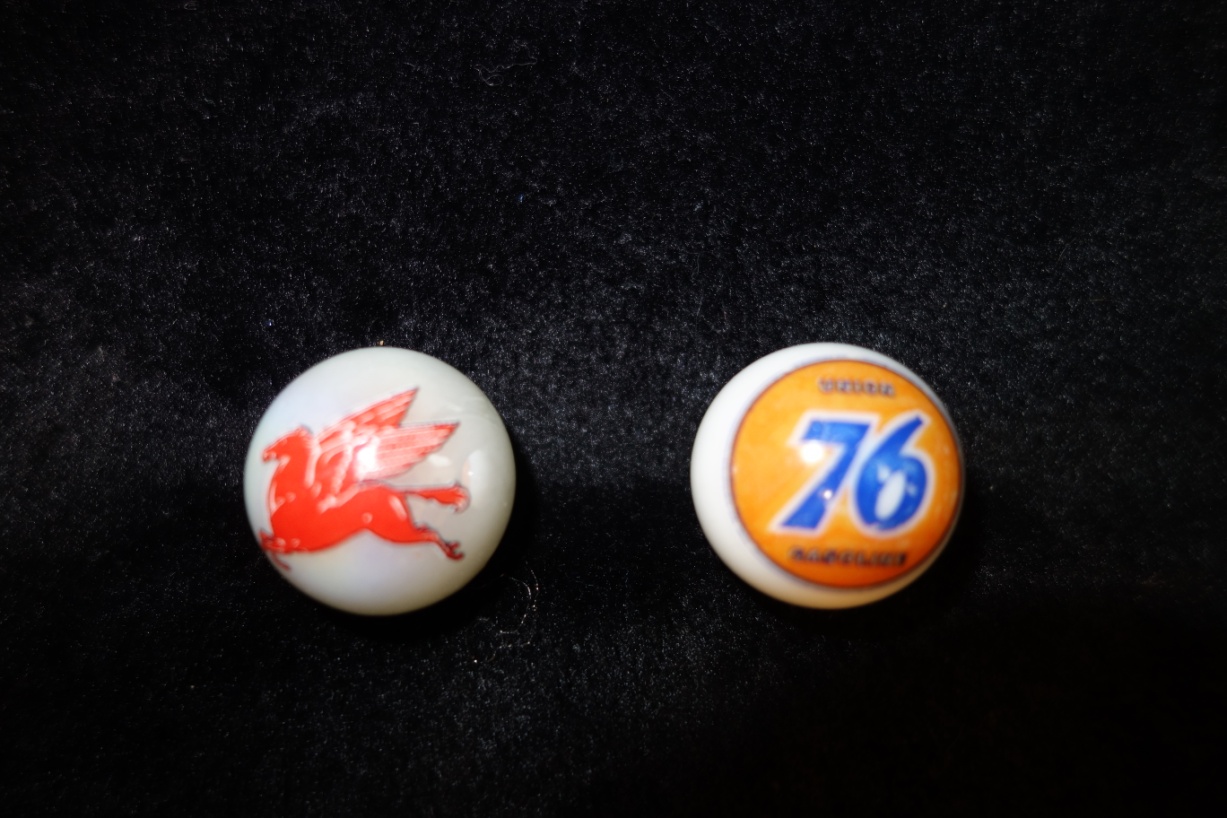 The Red Pegasus
The Red Pegasus
These two trademarks, the red Pegasus and blue “76” on an orange ball, are very often used on header cards for these fantasy marbles. They are often found in flea markets and antique shops. Both marbles are opaque white but only the Pegasus is opalescent.
In Greek mythology Pegasus was brilliant white. He was a winged stallion, one of the two children of Poseidon and Medusa.[8] This red Pegasus was first used in 1911 by Vacuum Oil in, of all places, South Africa. By 1911 Vacuum was an old well-established world-wide company.
The flying horse was adopted as a symbol of power and speed. Google tell us that in 1931, when Vacuum merged with Socony, the red Pegasus – a symbol of speed and power – was adopted as its U.S. trademark.
One odd fact: the real Pegasus trademark faces to the right. However, on the marble, he faces left![9]
Union 76
If possible, this marble is even easier to find than Pegasus. “Union Oil, for many years based in El Segundo, California, introduced “76” gasoline in 1932. The name referred to the 1776 United States Declaration of Independence, and was also the octane rating of the gasoline in 1932.”[10] Union 76 merged with Chevron in 2005.
Fun with Advertising Marbles
The Harley Davidson marble is a perennial favorite of collectors. No, Harley-Davidson, founded in 1903, wasn’t one person but four! And Hooters? Anything we might say would be superfluous.
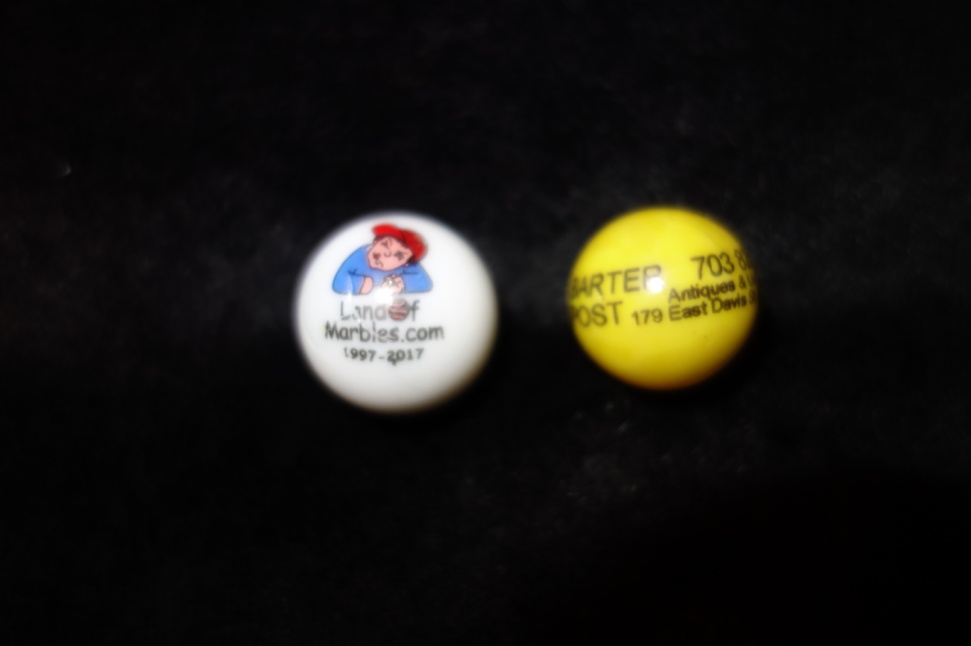
More Fun
Of all our advertising marbles the one we made practical use of is the Land Of Marbles. This marble is actually a coupon. We bought from Peter Caparelli at his Land of Marbles webstore for years and found some real bargains and unusual (like shipwreck) marbles there.
For his 20th anniversary Caparelli sent this marble along with a filled order. It has a coupon code on the reverse and, when you typed the code in the next time you placed an order, you got 10% off! It was a fun and innovative merchandising initiative. We were very disappointed when Caparelli folded his tent and closed his web store.
The bright yellow marble is an advertisement for the Barter Post in Culpeper, Virginia. We aren’t sure if they are still in business. We have been to hundreds of antique stores across America, and only a few offer marble advertisements. But if we ever get a free marble, we never forget the store!
And, finally, we used to have a big antique opaque glass marble, well over an inch and a half, which we bought in Jane Lew, West Virginia, and which had been used to advertise a car dealership.
You can find all kinds of bits and bobs to display your advertising marbles on. We dig up or find things like old glass fuse cases, antique milk glass cold cream and salve jars, old ink wells, and even drift wood. The marbles are cheap, their colors are bright and vibrant, and your imagination can do the rest! Visitors are attracted to them and they can be a lot of fun!
Foot Notes
- Just one example: Would you believe that Campbell’s Soup once put marbles in their Chicken & Stars soup while the New York-based advertising company BBDO was shooting an advertisement? Not true, right? Check “That Time Campbell’s Put Marbles in Their Soup” by Karl Smallwood, July 1, 2019 @ http://www.todayifoundout.com/index.php/2019/07/that-time-campbells-put-marbles-in-their-soup/ 6/16/2023↑
- Thank you keramikos for all your help! “Show and Tell” feature of Collectors Weekly @ https://www.collectorsweekly.com/stories/316003-help-can-anyone-tell-me-anything-about?in=activity (6/22/2023). The readers at Collectors Weekly were fantastic! They are knowledgeable & willing to share sources. It was a real learning experience for us. Thank each of you! ↑
- “American Firearms and Their Makers: A Research Guide Winchester” @ https://guides.loc.gov/american-firearms/gunmakers/winchester 6/20/2023 ↑
- https://olin.com/about-olin/history/ (6/20/2023). Again, thank you keramikos for all your help!↑
- If you want to see full-size Waterloo tractors visit the John Deere Tractor and Engine Museum in Waterloo @ https://www.roadsideamerica.com/story/48890 6/27/2023↑
- https://en.wikipedia.org/wiki/Waterloo_Gasoline_Engine_Company (11/15/2019). See the three articles & the printout of The American Snuff Company in the TUS 2438 Sleeve at the end of this section of the Catalog. (11/19/2019) ↑
- https://www.agweb.com/news/machinery/tractors/100-years-purchase-waterloo-boy 6/27/2023 ↑
- https://www.greekmythology.com/Myths/Creatures/Pegasus/pegasus.html 6/27/2023 ↑
- https://www.exxon.com/en 6/17/2023 ↑
- https://en.wikipedia.org/wiki/76_(gas_station) (6/27/2023) & https://snoqualmievalleymuseum.pastperfectonline.com/bysearchterm?keyword=76+Gas+Stations(6/27/2023) Today in America unleaded gasoline typically has octane ratings ranging from 87 (regular), to 91–94 (premium). In areas of high elevation you can sometimes find a rating of 85.↑

